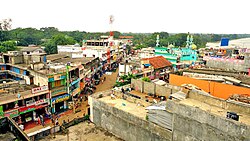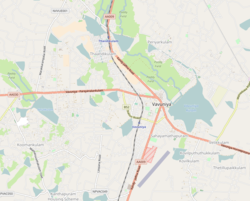Vavuniya
City in Sri Lanka From Wikipedia, the free encyclopedia
Vavuniya (Tamil: வவுனியா, romanized: Vavuniyā, Sinhala: වවුනියාව, romanized: Vavuniyāva) is a city in Vavuniya District in the Northern Province of Sri Lanka. The municipality is administered by an Municipal Council. The town has been known since ancient times, but being a heavily forested area, less than 100,000 people lived in the entire district before the Sri Lankan Civil War. The city is situated as a border town that divides the Tamil and Sinhalese population. To the south of the city are the Sinhala cities and to the north are the Tamil cities. The city has a large population of Tamils, Muslims and a significant number of Sinhalese. In the early days, Vavuniya was known as Vanni due to the abundance of Vanni Trees. The Security Forces Headquarters - Wanni is located in Vavuniya.
Vavuniya
| |
|---|---|
 Partial aerial view of Vavuniya | |
| Coordinates: 8°45′0″N 80°29′0″E | |
| Country | Sri Lanka |
| Province | Northern |
| District | Vavuniya |
| DS Division | Vavuniya South (Tamil) |
| Government | |
| • Type | Municipal Council |
| • Chairman | Gowthaman (TNA) |
| Area | |
| • Land | 2,248.96 ha (5,557.30 acres) |
| Elevation | 200 m (700 ft) |
| Demonyms |
|
| Time zone | UTC+5:30 (Sri Lanka Standard Time Zone) |
| Website | VUC |
History
This city has a long history of being ruled by the Sinhala kings, who built many tanks and placed Naga Sacred Guard Stones near them with inscriptions. They inherited the city from the ancient Yaka and Nagas of Sri Lanka.
Climate
Summarize
Perspective
Vavuniya has a tropical savanna climate (Köppen: As)[1] with warm to hot temperatures throughout the year and a distinct wet season from October to December. Temperatures are cooler from November to February compared to the rest of the year.
| Climate data for Vavuniya (1991–2020) | |||||||||||||
|---|---|---|---|---|---|---|---|---|---|---|---|---|---|
| Month | Jan | Feb | Mar | Apr | May | Jun | Jul | Aug | Sep | Oct | Nov | Dec | Year |
| Record high °C (°F) | 34.0 (93.2) |
36.0 (96.8) |
38.8 (101.8) |
40.1 (104.2) |
38.8 (101.8) |
38.5 (101.3) |
38.8 (101.8) |
38.4 (101.1) |
39.1 (102.4) |
38.1 (100.6) |
35.0 (95.0) |
33.0 (91.4) |
40.1 (104.2) |
| Mean daily maximum °C (°F) | 29.9 (85.8) |
31.5 (88.7) |
34.3 (93.7) |
34.9 (94.8) |
34.3 (93.7) |
34.4 (93.9) |
34.7 (94.5) |
34.6 (94.3) |
34.5 (94.1) |
32.6 (90.7) |
30.6 (87.1) |
29.6 (85.3) |
33.0 (91.4) |
| Daily mean °C (°F) | 25.5 (77.9) |
26.4 (79.5) |
28.4 (83.1) |
29.5 (85.1) |
29.7 (85.5) |
29.8 (85.6) |
29.9 (85.8) |
29.7 (85.5) |
29.6 (85.3) |
28.2 (82.8) |
26.7 (80.1) |
25.8 (78.4) |
28.3 (82.9) |
| Mean daily minimum °C (°F) | 20.9 (69.6) |
21.1 (70.0) |
22.4 (72.3) |
24.0 (75.2) |
25.0 (77.0) |
25.1 (77.2) |
24.9 (76.8) |
24.7 (76.5) |
24.4 (75.9) |
23.6 (74.5) |
22.7 (72.9) |
21.9 (71.4) |
23.4 (74.1) |
| Record low °C (°F) | 12.4 (54.3) |
10.5 (50.9) |
13.4 (56.1) |
15.3 (59.5) |
17.8 (64.0) |
18.8 (65.8) |
18.2 (64.8) |
18.2 (64.8) |
18.5 (65.3) |
16.0 (60.8) |
16.5 (61.7) |
13.0 (55.4) |
10.5 (50.9) |
| Average precipitation mm (inches) | 107.0 (4.21) |
76.2 (3.00) |
43.1 (1.70) |
123.1 (4.85) |
95.4 (3.76) |
21.1 (0.83) |
36.9 (1.45) |
63.9 (2.52) |
88.7 (3.49) |
230.0 (9.06) |
276.0 (10.87) |
249.1 (9.81) |
1,410.5 (55.53) |
| Average precipitation days (≥ 1.0 mm) | 7.1 | 4.7 | 3.9 | 9.2 | 5.8 | 2.1 | 2.6 | 4.1 | 5.7 | 13.3 | 17.1 | 12.5 | 88.0 |
| Source: NOAA[2] | |||||||||||||
Demographics
The total population of the Northern Province as per the statistics is 1.246 million, the lowest populous province in the country, with 606,678 males (47.3%) and 639,775 females (52.7%). The population density is 136 persons per Sq. km as against to 346 for the whole Island. The majority in the province live in areas classified as rural (84.5%), and only 15.5% of the population live in areas classified as urban. The majority of the population i.e. 89% in the province are Sri Lankan Tamils and others are Sri Lankan Moors, Sinhalese and Indian Tamils living in the province. Most of the Sri Lankan Tamils are Hindus, and the other religious persuasions in the province are Christians, Muslims, and a small number of Buddhists. The graph here shows the difference in ethnic composition from province to district to city. While usually, the city shows a more cosmopolitan nature than the province. The Vavuniya city reflects the composition of the district quite closely, even more so than the provincial percentages.
- Sri Lankan Tamils (84.3%)
- Sri Lankan Moors (8.22%)
- Sinhalese (6.52%)
- Indian Tamils (0.93%)
Electoral Wards
| Ward Number | Area |
|---|---|
| 1 | Thandikkulam |
| 2 | Paddanichipuliyankulam |
| 3 | Pandarikulam |
| 4 | Vairavarpuliyankulam |
| 5 | Kudiyiruppu |
| 6 | Kadai Veethi |
| 7 | Moondru Muripu |
| 8 | Rambaikulam |
| 9 | Sinnaputhukkulam |
| 10 | Kovilkulam |
Transport
Vavuniya railway station, which is located on the Northern Line connects Kankesanthurai (the northern terminus of the line) through to Colombo.[3] During the civil war Vavuniya was the terminus of the Northern Line.Vavuniya airport, which is an air force base and a domestic airport is also located here.[4] Vavuniya is situated in the middle of the Vanni region and is the gate to northern province where people can access all the northern cities quickly.
Educational Areas
Wikimedia Commons has media related to Vavuniya.
Vavuniya is divided into 4 educational divisions such as Vavuniya North, Vavuniya South, Vavuniya South-Sinhala division, Chettikulam. Vavuniya City comes under Vavuniya South Division
See also
- Vipulanantha College
- Nedunkerny
- Pandarikulam
- Nelukkulam
- Vavuniya kulam
- Vavuniya Tamil Madhya Maha Vidyalayam
- Rambaikulam Girls' Maha Vidyalayam
- Rambaikulam
- Rambaikulam SriGanavairavar kovil
References
Wikiwand - on
Seamless Wikipedia browsing. On steroids.




